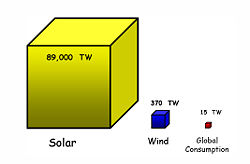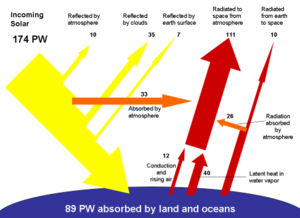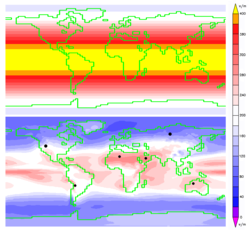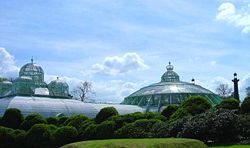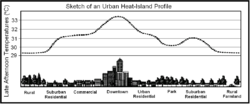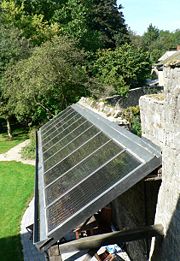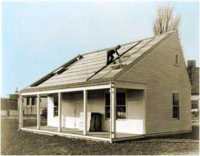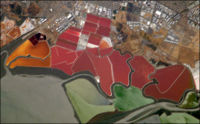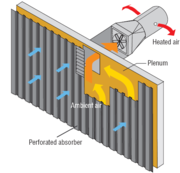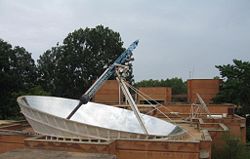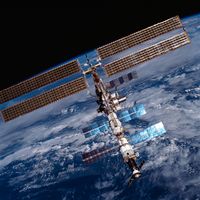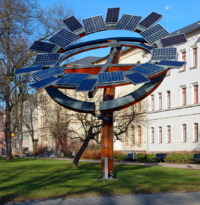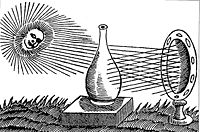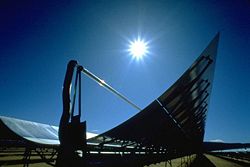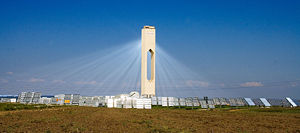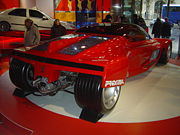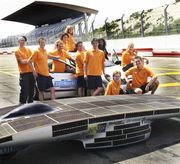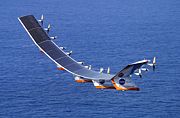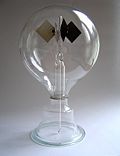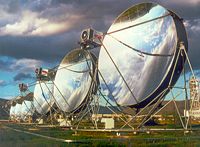Solar energy
2008/9 Schools Wikipedia Selection. Related subjects: Environment
| Renewable energy |
|---|
| Biofuels Biomass Geothermal Hydro power Solar power Tidal power Wave power Wind power |
Solar energy is energy directly from the Sun. This energy drives the climate and weather and supports virtually all life on Earth. Heat and light from the sun, along with solar-based resources such as wind and wave power, hydroelectricity and biomass, account for most of the available flow of renewable energy.
Solar energy technologies harness the sun's energy for practical ends. These technologies date from the time of the early Greeks, Native Americans and Chinese, who warmed their buildings by orienting them toward the sun. Modern solar technologies provide heating, lighting, electricity and even flight.
Solar power is used synonymously with solar energy or more specifically to refer to the conversion of sunlight into electricity. This can be done either through the photovoltaic effect or by heating a transfer fluid to produce steam to run a generator.
Solar photovoltaics provided 0.04% of the world's energy usage in 2004.
Energy from the Sun
Earth receives 174 petawatts of incoming solar radiation ( insolation) at the upper atmosphere at any given time. When it meets the atmosphere, 6 percent of the insolation is reflected and 16 percent is absorbed. Average atmospheric conditions (clouds, dust, pollutants) further reduce insolation traveling through the atmosphere by 20 percent due to reflection and 3 percent via absorption. These atmospheric conditions not only reduce the quantity of energy reaching the earth's surface, but also diffuse approximately 20 percent of the incoming light and filter portions of its spectrum. After passing through the atmosphere, approximately half the insolation is in the visible electromagnetic spectrum with the other half mostly in the infrared spectrum (a small part is ultraviolet radiation).
The absorption of solar energy by atmospheric convection (sensible heat transport) and evaporation and condensation of water vapor (latent heat transport) affects the winds and the water cycle. Upon reaching the surface, sunlight is absorbed by the oceans, land masses and plants. The energy captured in the oceans drives the thermohaline cycle. As such, solar energy is ultimately responsible for temperature-driven ocean currents such as the thermohaline cycle and wind-driven currents such as the Gulf Stream. The energy absorbed by the earth, in conjunction with that recycled by the Greenhouse effect, warms the surface to an average temperature of approximately 14 °C. The small portion of solar energy captured by plants and other phototrophs is converted to chemical energy via photosynthesis. All the food we eat, wood we build with, and fossil fuels we use are products of photosynthesis. The flows and stores of solar energy in the environment are vast in comparison to human energy needs.
- The total solar energy available to the earth is approximately 3850 zettajoules (ZJ) per year.
- Oceans absorb approximately 2850 ZJ of solar energy per year.
- Winds can theoretically supply 6 ZJ of energy per year.
- Biomass captures approximately 1.8 ZJ of solar energy per year.
- Worldwide energy consumption was 0.471 ZJ in 2004.
The upper map on the right shows how solar radiation at the top of the earth's atmosphere varies with latitude, while the lower map shows annual average ground-level insolation. For example, in North America, the average insolation at ground level over an entire year (including nights and periods of cloudy weather) lies between 125 and 375 W/m² (3 to 9 kWh/m²/day). At present, photovoltaic panels typically convert about 15 percent of incident sunlight into electricity; therefore, a solar panel in the contiguous United States, on average, delivers 19 to 56 W/m² or 0.45 - 1.35 kWh/m²/day.
Types of technologies
There are many technologies for harnessing solar energy. Applications span through the residential, commercial, industrial, agricultural and transportation sectors. Solar energy can be used to produce food, heat, light and electricity. The flexibility of solar energy is manifest in a wide variety of technologies such as cars, calculators, etc.
Agriculture and horticulture
Photosynthesis is an important photochemical interaction. Most life on Earth depends on the ability of plants to photosynthesize light. While easy to overlook, the efficient use of solar energy is a founding principle of agriculture. This principle takes special priority during times of shortage as seen during the Little Ice Age when Medieval European farmers employed elaborate field orientation and thermal mass techniques to convert as much sunlight into food as possible. Agricultural advancement continues optimizing the availability of light by carefully timing planting cycles, tailoring row orientation, staggering heights between rows, varying plant density, and many other methods.
Human communities have used plant material, especially wood, as fuel for many millennia. Today biomass is considered as a form of renewable energy but not as solar energy because the production is indirect. Fossil fuels were also originally created through plants using solar energy. The use of fossil fuels is not considered to be renewable energy.
Greenhouses control the use of solar heat and light to grow specialty crops. Primitive greenhouses were first used during Roman times to grow cucumbers for the Roman emperor Tiberius. In the 16th century the first modern greenhouses were built in Italy to conserve tropical plants that explorers returned with. Greenhouses remain an important part of modern horticulture. The largest greenhouse complex in the world is in Willcox, Arizona where 106 hectares of tomatoes and cucumbers are entirely grown under glass.
Architecture and urban planning
Solar design can provide practical lighting, comfortable temperatures, and improved air quality by tailoring building orientation, proportion, window placement, and material components to the local climate and environment. As climate varies by region so too will the features of solar-designed buildings. In the words of the first century Roman architect Vitruvius:
| “ | We must begin by taking note of the countries and climates in which homes are to be built if our designs for them are to be correct. One type of house seems appropriate for Egypt, another for Spain...one still different for Rome, and so on with lands and countries of varying characteristics. This is because one part of the Earth is directly under the sun's course, another is far away from it, while another lies midway between these two....It is obvious that designs for homes ought to conform to diversities of climate. | ” |
Urban heat islands (UHI) are metropolitan areas with higher temperatures than the surrounding environment. These higher temperatures are the result of urban materials such as asphalt and concrete that have lower albedos and higher heat capacities than the natural environment. A straightforward method of counteracting the UHI effect is to paint buildings and roads white and plant trees. A hypothetical "cool communities" program in Los Angeles has projected that urban temperatures could be reduced by approximately 3 °C after planting ten million trees, reroofing five million homes, and painting one-quarter of the roads. The estimated cost of the cool communities program is approximately US$1 billion, with an annual benefit estimated at $170 million resulting from reduced air-conditioning costs alone. An additional $360 million in health costs could be saved annually by the associated reductions in smog.
Solar lighting
The history of lighting is dominated by the use of natural light. The Romans recognized the Right to Light as early as the 6th century and English law echoed these judgments with the Prescription Act of 1832. It wasn't until the 20th century that artificial lighting took over as the main source of interior illumination. The 1973 oil and 1979 energy crises brought attention to conservation measures such as natural lighting but interest waned on both occasions with the restoration of energy supplies. Approximately 22 percent (8.6 EJ) of the electricity used in the United States is for lighting. When daylighting techniques are appropriately applied, natural light can supply interior lighting for a significant portion of the day.
Daylighting systems collect and distribute sunlight to provide interior illumination. These systems directly offset energy use by replacing artificial lighting and indirectly offset energy use by reducing cooling loads. Although difficult to quantify, the use of natural lighting also offers physiological and psychological benefits compared to artificial lighting. Daylighting design carefully selects window type, size, and orientation and may consider exterior shading devices as well. Individual features include sawtooth roofs, clerestory windows, light shelves, skylights and light tubes. These features may be incorporated into existing structures but are most effective when integrated in a solar design package that accounts for factors such as glare, heat gain, heat loss and time-of-use. Architectural trends increasingly recognize daylighting as a cornerstone of sustainable design.
Hybrid solar lighting (HSL) is an active solar method of using sunlight to provide illumination. Hybrid solar lighting systems collect sunlight using focusing mirrors that track the sun. The collected light is transmitted via optical fibers into a building's interior to supplement conventional lighting. In single-story applications, these systems are able to transmit 50 percent of the direct sunlight received.
Daylight saving time (DST) utilizes solar energy by matching available sunlight to the time of the day in which it is most useful. DST shifts electricity use from evening to morning hours thus lowering evening peak loads and the higher costs associated with peaking electricity. In California, winter season DST has been estimated to cut daily peak load by 3 percent and total electricity use by 3400 MWh. DST has been estimated to reduce early spring and late fall peak loads by 1.5 percent and total daily electricity use by 1000-2000 MWh. DST, like other solar energy technologies, has not proven successful in all regions.
Solar thermal
Solar thermal applications make up the most widely used category of solar energy technology. These technologies use heat from the sun for water and space heating, ventilation, industrial process heat, cooking, water distillation and disinfection, and many other applications.
Water heating
Solar hot water systems use sunlight to heat water. Commercial solar water heaters began appearing in the United States in the 1890s. These systems saw increasing use until the 1920s but were gradually replaced by relatively cheap and more reliable conventional heating fuels. The economic advantage of conventional heating fuels has varied over time resulting in periodic interest in solar hot water; however, solar hot water technologies have yet to show the sustained momentum they had until the 1920s. Recent price spikes, erratic availability of conventional fuels, and other factors are renewing interest in solar heating technologies. Approximately 14 percent (15 EJ) of the total energy used in the United States is for water heating. In many climates, a solar heating system can provide 50 to 75 percent of domestic hot water use.
As of 2006, the total installed capacity of solar hot water systems is 104 GWth and growth is 15-20 percent per year. China is the world leader in the deployment of solar hot water systems with 80% of the market. Israel is the per capita leader in the use of solar hot water with 90 percent of homes using this technology. In the United States heating swimming pools is the most successful application of solar hot water.
Solar water heating technologies have high efficiencies relative to other solar technologies. Performance will depend upon the site of deployment, but flat-plate and evacuated-tube collectors can be expected to have efficiencies above 60 percent during normal operating conditions. In addition, solar water heating is particularly appropriate for low-temperature (25-70 °C) applications such as swimming pools, domestic hot water, and space heating. The most common types of solar water heaters are batch systems, flat plate collectors and evacuated tube collectors.
Heating, cooling and ventilation
Heating, ventilation, and air conditioning (HVAC) systems of buildings are closely interrelated. All seek to provide thermal comfort, acceptable indoor air quality, and reasonable installation, operation, and maintenance costs. Conventional HVAC systems account for roughly 28 percent of the energy used in the United States and European Union. Many solar heating, cooling, and ventilation technologies can be used to offset a portion of this energy.
Thermal mass materials store solar energy during the day and release this energy during cooler periods. Common thermal mass materials include stone, cement, and water. The proportion and placement of thermal mass should consider several factors such as climate, daylighting, and shading conditions. When properly incorporated, thermal mass can passively maintain comfortable temperatures while reducing energy consumption. More advanced thermal mass systems can be also be used for ventilation.
A solar chimney (or thermal chimney) is a passive solar ventilation system composed of a hollow thermal mass connecting the interior and exterior of a building. As the chimney warms, the air inside is heated causing an updraft that pulls air through the building. These systems have been in use since Roman times and remain common in the Middle east.
A Trombe wall is a passive solar heating and ventilation system consisting of an air channel sandwiched between a window and a sun-facing thermal mass. During the ventilation cycle, sunlight stores heat in the thermal mass and warms the air channel causing circulation through vents at the top and bottom of the wall. During the heating cycle the Trombe wall radiates stored heat. Solar roof ponds are a unique solar heating and cooling technology developed by Harold Hay in the 1960s. A basic system consists of a roof mounted water bladder with a movable insulating cover. This system can control heat exchange between interior and exterior environments by covering and uncovering the bladder between night and day. When heating is a concern the bladder is uncovered during the day allowing sunlight to warm the water bladder and store heat for evening use. When cooling is a concern the covered bladder draws heat from the building's interior during the day and is uncovered at night to radiate heat to the cooler atmosphere. The Skytherm house in Atascadero, California uses a prototype roof pond for heating and cooling. Active solar cooling can be achieved via absorption refrigeration cycles, desiccant cycles, and solar mechanical processes. In 1878, Auguste Mouchout pioneered solar cooling by making ice using a solar steam engine attached to a refrigeration device. Thermal mass, smart windows and shading methods can also be used to provide cooling. The leaves of deciduous trees provide natural shade during the summer while the bare limbs allow light and warmth into a building during the winter. The water content of trees will also help moderate local temperatures.
Process heat
Solar thermal technologies can provide process heat for drying food and clothes, driving high temperature chemical reactions and melting metals.
A solar pond is a pool of salt water (usually 1-2 meters deep) that collects and stores solar energy. Solar ponds were first proposed by Dr. Rudolph Bloch in 1948 after he came across reports of a lake in Hungary in which the temperature increased with depth. This effect was due to salts in the lake's water, which created a "density gradient" that prevented convection currents. A prototype was constructed in 1958 on the shores of the Dead Sea near Jerusalem. The pond consisted of layers of water that successively increased from a weak salt solution at the top to a high salt solution at the bottom. This solar pond was capable of producing temperatures of 90 °C in its bottom layer and had an estimated solar-to-electric efficiency of two percent. Current representatives of this technology include a 150 kW pond in Ein Bokek, Israel, and another used for industrial process heat at the University of Texas El Paso.
Salt evaporation ponds use solar energy to concentrate brine solutions used in leach mining, remove dissolved solids from waste streams, or obtain salt from sea water. An evaporation pond consists of a shallow layer of water that can evaporate at a rate of 3-6 mm/day. The use of evaporation ponds to obtain salt from sea water is one of the oldest applications of solar energy, and evaporation ponds remain one of the largest commercial applications of solar energy used today.
A transpired air collector is a perforated sun-facing wall first introduced in the early nineties. The wall absorbs sunlight and pre-heats air as much as 22 °C as it is drawn into the ventilation system. These systems are highly efficient (up to 80 percent) and can pay for themselves within 3 to 12 years in offset heating costs. Representatives include an 860 m² collector in Costa Rica used for drying coffee beans and a 158 m² collector in Quebec, Canada used for drying chicken manure.
Cooking
Solar cookers use sunlight for cooking, drying and pasteurization. Solar cookers offset fuel costs, reduce demand for fuel or firewood, and improve air quality by reducing or removing a source of smoke.
The simplest class of solar cooker is the box cooker. Horace de Saussure built the first box cooker in 1767 after observing: "It is a known fact, and a fact that has probably been known for a long time, that a room, a carriage, or any other place is hotter when the rays of the sun pass through glass." A basic box cooker consists of an insulated container with a transparent lid. These cookers can be used effectively with partially overcast skies and will typically reach temperatures of 50-100 °C. The economy, simplicity and performance of box cookers contribute to the popularity of this design.
Concentrating solar cookers use reflectors to concentrate light on a cooking container. The most common reflector geometries are flat plate, disc and parabolic trough type. These designs cook faster and at higher temperatures (up to 315 °C). As with other concentrating technologies, these cookers require direct light and must be repositioned to "track" the sun.
Desalination and disinfection
A solar still uses solar energy to distill water. The main types are cone shaped, boxlike, and pit. The box shaped types are most sophisticated of these and the pit types the least sophisticated. In cone solar stills, impure water is inserted into the container, where it is evaporated by sunlight coming through clear plastic. Free of solids in suspension or solution, the water vapor condenses on top and drips down to the side, where it is collected and removed.
Solar water pasteurization uses solar energy to disinfect water by holding it at a temperature above 60 °C for a specified period.
Solar water disinfection (SODIS) is another method of disinfecting water using sunlight. A clear container is three-quarters filled with water, shaken vigorously for 20 seconds, closed and placed in the sun. Shaking aerates the water and begins disinfection. As sunlight shines into the container, the UV-A radiation causes the dissolved oxygen to become highly reactive. This reactive form of oxygen prevents microorganisms from breeding and also kills many of them directly. As the container warms, harmful organisms are also destroyed by heat treatment. Although endorsed by the World Health Organization, SODIS is not as effective as pasteurization and the completeness of disinfection is not easily measurable.
Electricity generation
Electricity can be generated from the sun in several ways. Photovoltaics (PV) has been mainly developed for small and medium-sized applications, from the calculator powered by a single solar cell to the PV power plant. For large-scale generation, concentrating solar thermal power plants have been more common but new multi-megawatt PV plants have been built recently. Other solar electrical generation technologies are still at the experimental stage.
Photovoltaics
A solar cell or photovoltaic cell is a device that converts light into electricity using the photoelectric effect. The first working solar cells were constructed by Charles Fritts in 1883. These prototype cells were made of selenium and achieved efficiencies around one percent. Following the fundamental work of Russell Ohl in the 1940s, researchers Gerald Pearson, Calvin Fuller and Daryl Chapin created a solar cell made of silicon in 1954.
In 1958, photovoltaic modules were used successfully as a power source for the Vanguard I satellite. This example was followed by many other Soviet and American satellites, so that by the late 1960s PV had become the established source of power for satellites. It played an essential part in the success of early commercial satellites such as Telstar and Syncom.
For terrestrial applications the cost of PV was the main limiting factor. It remained above $100 per watt throughout the 1960s. However, work by Elliot Berman during the early 1970s lowered the cost to $20 per watt and this price reduction made PV generation competitive in a range of applications, especially in remote areas without connection to a power grid. Uses included cathodic protection of pipelines and power for off-shore oil rigs, railroad crossings and lighthouses.
The 1973 oil and 1979 energy crises provided a further impetus to PV development. A search for alternatives to oil resulted in incentive programs such as the Federal Photovoltaic Utilization Program in the USA and the Sunshine Program in Japan. Research facilities were established such as the Solar Energy Research Institute (now NREL) in the USA, the New Energy and Industrial Technology Development Organization (NEDO) in Japan, and the Fraunhofer Institute for Solar Energy Systems ISE in Germany.
When oil prices began to fall in the early 1980s the growth of PV was slowed. In the context of historically-low oil prices from 1986-1999, funding for PV research was relatively low and the issue was not high in public consciousness.Nevertheless, the output of PV-generated electricity grew by 10 to 20 percent per year throughout the 1980s and 1990s. By 1999, the worldwide capacity of PV had reached 1000 MW.
Total of installed PV is around 6,000 MWp (Mega- watt-peak) as of the end of 2006. It is projected to reach more than 9,000 MWp by the end of 2007.
With many jurisdictions now giving tax and rebate incentives, PV installations can pay for themselves in five to ten years in many places. "Grid-connected" systems - those systems that use an inverter to connect to the utility grid instead of relying on batteries - now make up the largest part of the market. While the deployment of PV power depends largely upon local conditions and requirements, most countries are taking an interest in developing PV as one of their options for renewable energy supply.
Concentrating solar
Concentrated sunlight has been used to perform useful tasks from the time of ancient China. A legend claims Archimedes used polished shields to concentrate sunlight on the invading Roman fleet and repel them from Syracuse in 212 BC. Leonardo Da Vinci conceived using large scale solar concentrators to weld copper in the 15th century. In 1866, Auguste Mouchout successfully powered a steam engine with sunlight, the first known example of a concentrating solar-powered mechanical device. Over the following 50 years, inventors such as John Ericsson, and Frank Shuman developed solar-powered devices for irrigation, refrigeration and locomotion. The progeny of these early developments are the concentrating solar thermal power plants of today.
Concentrating Solar Thermal (CST) systems use lenses or mirrors and tracking systems to focus a large area of sunlight into a small beam. This is then used to generate electricity. Moreover, the high temperatures produced by CST systems can be used to provide process heat and steam for a variety of secondary commercial applications (cogeneration). However, CST technologies require direct insolation to function and are of limited use in locations with significant cloud cover. The main methods for producing a concentrated beam are the solar trough, solar power tower and parabolic dish; the solar bowl is more rarely used. Each concentration method is capable of producing high temperatures and high efficiencies, but they vary in the way they track the sun and focus light.
A solar trough consists of a linear parabolic reflector that concentrates light onto a receiver positioned along the reflector's focal line. The reflector is made to follow the sun during the daylight hours by tracking along a single axis. A working fluid (oil, water) flows through the receiver and is heated to 500 °C before transferring its heat to a distillation or power generation system. Trough systems are the most developed CST technology. The Solar Electric Generating System (SEGS) plants in California and Plataforma Solar de Almería's SSPS-DCS plant in Spain are representatives of this technology.
A parabolic dish or dish/engine system consists of a stand-alone parabolic reflector that concentrates light onto a receiver positioned at the reflector's focal point. The reflector tracks the sun along two axes. A working fluid (hydrogen, helium, air or water) flows through the receiver where it is heated to 1000 °C before transferring its heat to a Stirling engine for power generation. Parabolic dish systems display the highest solar-to-electric efficiency among CST technologies and their modular nature offers scalability. The Stirling Energy Systems (SES) and Science Applications International Corporation (SAIC) dishes at UNLV and the Big Dish in Canberra, Australia, are representatives of this technology.
A solar power tower consists of an array of flat reflectors ( heliostats) that concentrate light on a central receiver atop a tower. Focusing is critical and the reflectors track the sun through the day and the year on two axes. A working fluid (air, water, molten salt) flows through the receiver where it is heated up to 1500 °C before transferring its heat to a power generation or energy storage system. Power towers are less advanced than trough systems but they offer higher efficiency and better energy storage capability. The Solar Two in Daggett, California and the Planta Solar 10 (PS10) in Sanlucar la Mayor, Spain are representatives of this technology.
A solar bowl consists of a fixed parabolic reflector that concentrates light onto a receiver which tracks the focus of light as the sun moves across the sky. One has been constructed in Marseilles, France and another in Auroville, India.
Concentrating Photovoltaic (CPV) systems convert concentrated light into electricity by PV rather than heat engines. They also use tracking systems, mirrors, and lenses to achieve high concentration ratios and are able to reach efficiencies above 40%. A solar power station planned for Victoria, Australia will use heliostat concentrating PV technology similar to the power tower concept.
Experimental solar power
- A solar updraft tower (also known as a solar chimney or solar tower) consists of a large greenhouse that funnels into a central tower. As sunlight shines on the greenhouse, the air inside is heated and expands. The expanding air flows toward the central tower where a turbine converts the air flow into electricity. A 50 kW prototype was constructed in Ciudad Real, Spain and operated for eight years before decommissioning in 1989.
- Thermoelectric devices convert a temperature difference between dissimilar metals into an electric current between those metals. The solar pioneer Mouchout envisioned using the thermoelectric effect to store solar energy for later use; however, his experiments toward this end never progressed beyond primitive devices.
- Photoelectrochemical cells or PECs are a special class of solar cells. Each cell consists of a semiconducting photoanode and a metal cathode immersed in an electrolyte. Some photoelectrochemical cells produce electrical energy while others produce hydrogen in a process similar to the electrolysis of water. Graezel or dye-sensitized solar cells are a representative of this technology.
Sunshine to Petrol
Sunshine to Petrol (S2P) technology seeks to use heat from concentrated sunlight to drive chemical reactions that allow carbon dioxide gas in the atmosphere to be broken down into oxygen and carbon monoxide. The CO may then be used to artificially synthesize gasoline. This could be then used in conventional internal combustion engines (ICE) or as an energy storage medium.
Solar vehicles
Development of a practical solar powered car has been an engineering goal since the 1980s. Solar cars are generally powered by PV panels positioned on the vehicle. The centre of this development is the World Solar Challenge, a biannual solar-powered car race in which teams from universities and enterprises compete over 3,021 km (1,877 mi) across central Australia from Darwin to Adelaide. In 1987, when it was founded, the winner's average speed was 67 km/h (42 mph) The 2007 race included a new challenge class using cars with an upright seating position and which, with little modification, could be a practical proposition for sustainable transport. The winning car averaged 90.87 km/h (56.46 mph).
The batteries of electric bicycles may be charged from solar-generated electricity; alternatively a PV panel may be located on the bicycle itself.
The first practical solar boat was constructed in 1975 in England. By 1995, passenger boats incorporating PV panels began appearing and are now used extensively. The first crossing of the Atlantic Ocean by a solar-powered boat was in the winter of 2006/2007 by the catamaran sun21.
Helios, named for the Greek sun god, was a prototype PV-powered unmanned aircraft. AeroVironment, Inc. developed the vehicle under NASA's Environmental Research Aircraft and Sensor Technology (ERAST) program. On 13 August, 2001, it set an unofficial world record for sustained altitude by a winged aircraft. It sustained flight above 29,250 m (95,965 ft) for 40 minutes and reached 29,524 m (96,864 ft) altitude in the process.
A solar balloon is a black balloon that is filled with ordinary air. As sunlight shines on the balloon, the air inside is heated and expands, causing an upward buoyancy force, much like an artificially-heated hot air balloon. Some solar balloons are large enough for human flight, but usage is limited to the toy market as the surface-area to payload-weight ratio is rather high.
Solar sails are a proposed form of spacecraft propulsion using large membrane mirrors. Radiation pressure is small and decreases by the square of the distance from the sun, but unlike rockets, solar sails require no fuel. Although the thrust is small compared to rockets, it continues as long as the sun shines and the sail is deployed and in the frictionless vacuum of space significant speeds can eventually be achieved.
Solar chemical
Solar chemical processes use light (photonic) and heat from the sun to drive chemical reactions. These processes offset energy that would otherwise be required from an alternate source, produce no pollution, and can serve as reversible method of storing solar energy. Pioneering work in photochemistry by Schenck et al. in 1943 successfully produced the anti-helminthic drug ascaridole. Solar chemical technologies are currently at the experimental stage with the primary focus on concentrating solar thermal technologies.
- Zinc Oxide (ZnO) can be decomposed at high temperatures (1200-1750 °C). The resulting pure zinc can be marketed directly or the zinc can be reacted with water at 350 °C to produce ZnO and hydrogen.
- A solar furnace can be used to produce high purity lime and can reduce CO2 emissions associated with cement production by 20-40%. A prototype 10 kWth solar furnace at the Paul Scherrer Institute produced lime at 64.2 grams per minute with a solar energy to chemical energy efficiency of 34.8%.
- Water can be directly dissociated at high temperatures (2300-2600 °C). These process have so far been limited due to their high level of complexity and low solar-to-hydrogen efficiency (1-2%).
Solar mechanical
Solar mechanical technologies use sunlight to produce a mechanical effect. They were widely investigated by solar pioneers such as Auguste Mouchout, John Ericsson, Charles Tellier and Frank Shuman. These devices generally concentrated sunlight on a boiler to produce steam which was then used by a steam engine to perform useful work. Most of these technologies were displaced early in the 20th century as increasingly cheap fossil fuels made them economically noncompetitive but several solar mechanical technologies have since been developed.
- A light mill or Crookes radiometer is a simple solar mechanical device consisting of a glass bulb containing a set of vanes mounted on a spindle. Each vane has a dark side (which absorbs light energy and changes it to heat energy) and a reflective side (which stays relatively cool). Due to the motion of gases around the hot and cool sides of each vane, the vanes rotate with the dark side retracting, and the reflective side advancing towards the light. The rotation is proportional to the intensity of light. The power levels are low however and no practical application has been found for this device
- Passive solar tracking devices use imbalances caused by the movement of a low boiling point fluid to track the movement of the sun. These systems can improve performance by 25% over fixed tilt PV systems.
- Passive solar shading systems also reposition with the sun according to the movement of balancing fluids. They are used in buildings to maximize natural lighting during winter, and reduce summer glare and cooling loads.
Energy storage
Storage is an important issue in the development of solar energy because continuous availability is a vital requirement of modern energy use. Directly generated solar energy is obviously only available in the hours of daylight.
Solar energy is most often stored as heat or as electrical energy. Mechanical storage in the form of flywheels or compressed gas under pressure have also been tried.
Thermal mass storage
Thermal mass systems use various methods and materials (adobe, earth, concrete, water) to store solar energy for short or long durations ( seasonal thermal store). Thermal mass can be used to lower peak demand, shift time-of-use to off-peak hours and reduce overall heating and cooling requirements.
Solar energy can be stored thermochemically with phase change materials. Suitable materials may be organic ( paraffins, fatty acids) or inorganic (salts, metals, alloys).
- A Paraffin wax thermal storage system consists of a solar hot water loop connected to a paraffin wax tank. During the storage cycle, hot water flows through the storage tank melting the paraffin. The enthalpy of fusion for paraffin is 210-230 kJ/kg. During the heating cycle, stored heat is extracted from the tank as the wax resolidifies. These systems heat air and water to 64 °C and can reduce conventional energy use by 50 to 70 percent.
- Eutectic salts such as Glauber's salt also can be employed in thermal storage systems. Glauber's salt is relatively inexpensive and readily available. It can store 347 kJ/kg and deliver heat at 64 °C. The "Dover House" (in Dover, Massachusetts) was the first to use a Glauber's salt heating system in 1948.
It can also be stored at high temperatures in materials in which there is no phase change but which have a high specific heat.
- Solar energy can be stored at high temperatures using molten salts. Salts are an effective storage medium because they are non-flammable, nontoxic, low-cost, have a high specific heat capacity, and can deliver heat at temperatures compatible with conventional power systems. A molten salt storage system consists of a salt loop connected to an insulated storage tank. During the heating cycle, the salt mixture is heated from 290 °C to 565 °C. During the power cycle, the salt is used to make steam for a thermal power station. The Solar Two used this method of energy storage, allowing it to store 1.44 TJ (400,000 kWh) in its 68 m³ storage tank with an annual storage efficiency of about 99 percent.
Electrical storage
Rechargeable batteries can be used to store excess electricity from a photovoltaic system. This type of storage system consists of a photovoltaic power source connected to a battery bank via a charge controller and inverter. Lead acid batteries are the most common type of battery associated with photovoltaic systems because of their relatively low upfront costs and high availability. Lead acid batteries have an energy density of 110-140 kJ/kg, a charge/discharge efficiency of 70-92 percent and cost $150-200 per kWh ($45 to $55 per MJ). Lead batteries used in off-grid applications should be sized for three to five days of capacity and should limit depth of discharge to 50 percent to minimize cycling and prolong battery life. Newer batteries can be deep discharged for over 25,000 cycles.
Excess electricity from photovoltaic systems also can be sent to the transmission grid where it can be used to meet existing demand or temporarily stored for later use. Grid-tied electrical system policies often give photovoltaic system owners a credit for the electricity they deliver to the grid. This credit is used to offset electricity provided from the grid when the photovoltaic system cannot meet demand. Where there is net metering, the credit is equivalent to or greater than the cost of electricity to the consumer.
Other forms of grid storage
Pumped-storage_hydroelectricity is another form of storage that can be used even out the supply of electricity from solar and other renewables. See also Grid_energy_storage for general grid storage solutions.
Development, deployment and economics
The following trends are a few examples by which the solar market is being helped to become competitive:
- Net metering laws which give credit for electricity fed into the grid. The Electricity Feed Law in Germany is currently the main driver of PV growth in the world.
- Incentives such as rebates and tax credits at the federal, state and local level to encourage consumers to consider solar power.
- Government grants for fundamental research in solar technology to make production cheaper and improve efficiency.
- Development of solar loan programs which lower deployment costs. The Indian Solar Loan Programme sponsored by UNEP has brought solar power to 18,000 homes in Southern India. Success in India's solar program has led to similar projects in other developing areas such as Tunisia, Morocco, Indonesia and Mexico.
Solar energy associations
Worldwide
- International Solar Energy Society (ISES) International NGO supporting renewable and sustainable technologies and member of the International Renewable Energy Alliance (IREA).
Europe
- ESTIF - European Solar Thermal Industry Federation
North America
- ASES: American Solar Energy Association US organization supporting solar energy, efficiency and sustainable technologies.
- SEIA: Solar Energy Industries Association US trade association of solar energy manufacturers, dealers, distributors, contractors
- Canadian Solar industry Association
- ANES: Mexican Solar Energy Association
- Prometheus Institute for Sustainable Development US non-profit which promotes PV, solar thermal and other sustainable technologies.
Solar energy research institutes
- See also: Photovoltaics research institutes
There are many research institutions and departments at universities around the world that research aspects of solar energy. Countries that are particularly active include Germany, Spain, Japan, Israel, Australia, China, and the USA.
- Solar Energy Laboratory at University of Southampton
- National Renewable Energy Laboratory NREL
- Centre for Renewable Energy Systems Technology, at Loughborough University
- Centre for Sustainable Energy Systems at the Australian National University
- Florida Solar Energy Centre
- Solar Energy Laboratory at UW Madison

